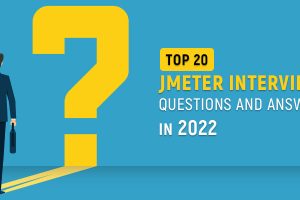
Top 20 JMeter Interview Questions and Answers in 2022
Jmeter alternatively referred to as Apache JMeter is an open-source testing tool to test the performance of web applications. This automated tool runs on the Java platform and the best-rated software to retain potential customers for the website business. If your application keeps on loading with slow response times, then customers are likely to get frustrated and switch to better applications. If you are looking forward to cracking the testing interview, then we have it all covered in this section with the most frequently asked JMeter interview questions and answers.
JMeter Interview Questions and Answers:
- Explain the mechanism of JMeter. JMeter represents a number of users collectively sending requests to a common server to evaluate the response time of the server and records the performance of the web application through graphs.
- How do you incorporate variables and functions in JMeter? Variables and functions are passed as parameters into any field of the test data.
- Are test plans built on JMeter OS dependent? These test plans are static and saved in XML format. So, not dependent on any OS and can be run on any OS that is compatible with JMeter.
- List the two types of processors in JMeter. Pre-processor and Postprocessor.
- Specify the execution hierarchy of Test Elements.
- Configuration elements
- Pre-processor elements
- Timers
- Samplers
- Post-processors
- Assertions
- Listeners
- Describe Configuration elements. A configuration element works on par with a sampler in a test run and is useful for setting up variables for future use by samplers. These elements are run initially before any samplers in the test scope.
- What are a timer in JMeter and its types? A JMeter thread will keep on sending requests to the server and to initiate breaks between requests timers are incorporated. Types of timers include Constant Timer, Gaussian Random Timer, Synchronizing Timer, and Uniform Random Timer.
- How is spike testing done in JMeter? Spike testing is achieved with the help of a synchronization timer. This timer accommodates all the threads passed and blocks them until it reaches the specified threshold limit and then sends them unitedly creating a maximum load.
- Explain distributed load testing in JMeter. The usage of multiple systems for performing a load test on an application via the master-slave configuration is the working concept of distributed load testing. Hence, the stress on a single source is reduced leading to improved outputs.
- List the benefits of JMeter in the aspect of performance testing.
- JMeter is used to evaluate the performance of both static and dynamic resources.
- The tool is capable of handling a maximum number of users simultaneously.
- JMeter creates graphical metrics of the previously run performance reports.
- What is a test fragment? It is an element incorporated and influenced by a controller either a module controller or an Include controller.
- Brief about an assertion in JMeter and its types. Assertion validates the test server by finding whether it produces the expected results or not. The five types of assertion are response, duration, size, XML, and HTML.
- How do you implement the reusability concept in JMeter test scripts? Reusability is achieved by setting up elements like “CSV Set Data Config” and “User-Defined Variables”. By using a module controller to implement shared tasks.
- Explain the concept of data parameterization in JMeter. Data parameterization helps in reusing the same script eliminating the need for passing the values again for the same request with unique parameters.
- What are the differences between JMeter and Load Runner? JMeter is an open-source tool while Load Runner is licensed software. JMeter does not have a UI whereas LoadRunner has an intuitive UI. The former is not compatible with SAP and Siebel while the latter is compliant with SAP, Siebel, and PeopleSoft.
- List the plug-ins supported by JMeter.
- Thread group plug-in.
- Apache JMeter.
- Samplers Plug-in.
- Listeners Plug-in.
- What are the significant features of the JMeter tool? Extensibility, portability, and robustness are the three key features of this innovative tool. In addition, results can be generated in graphical form and the test scripts can be created instantaneously which is attributed to the playback feature inbuilt within the tool.
- Explain the concept of Workbench in JMeter. Workbench stores the test elements for running the tasks back to back in JMeter. A browser present within this tool is responsible for storing the parameters on the temporary space.
- Find out the element that represents a group of users who perform a wide range of operations. The Thread Group is the proactive element in JMeter that represents multiple users and performs tasks concurrently without any interruption.
- Explain the role of configuration elements. Processing the requests and segregating them from the sampler is a crucial task, which is achieved effortlessly via config elements. It is also used for integrating the requests received from the sampler along with the parameters listed in the CSV file.
Conclusion:
Hope the above FAQs will be helpful in cracking the JMeter interview to settle in your dream job. We wish you all the best in becoming successful testing professional.
The JMeter training in the USA is also available in India in online mode. You can learn everything from top to bottom by sitting at your home only just by enrolling your details at the Get Software Services Website.

